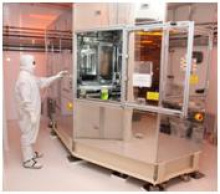DuPont Displays Inc. (DDI) has developed a novel way of printing color-tunable OLED lighting panels that keeps manufacturing costs low. The method involves processing the organic layers from solution, with most of the process steps taking place under atmospheric conditions rather than in a high vacuum. Industry-standard slot-coating methods are used in conjunction with nozzle printing—in which the solutions of organic materials are continuously jetted through an array of nozzles moving at high speed—allowing the light-emitting materials to be spatially patterned.
The spatially patterned design enables the lighting panel to be color-tunable, in much the same way as a TV screen. DDI's 50 cm2 prototypes were incorporated into task-lighting luminaires that were tunable from a CCT of 2700K to 6500K. Panels achieved an efficacy of 35 lm/W at ~2700K (expected to improve to 40 lm/W with minor optimization). Operating lifetimes easily met the 5,000-hour target. Uniformity of the printed layers was demonstrated to be high, giving excellent luminance uniformity.
A detailed cost model of Gen4- and Gen5-scale manufacturing predicts that module costs will drop to ~$25 for a 1,000 cm2 panel ($25 per klm), based on a realistic evolution of materials costs and performance improvements over the next few years. The low manufacturing cost is partly due to the high throughput of the nozzle-printing technique: a single Gen4-sized nozzle printer is expected to produce over 200,000 lighting panels (each one 1,000 cm2) per month. The use of nozzle printing also gives a manufacturer the flexibility to easily change materials or the device layout through software rather than with mechanical tooling.
Return to Research Highlights

